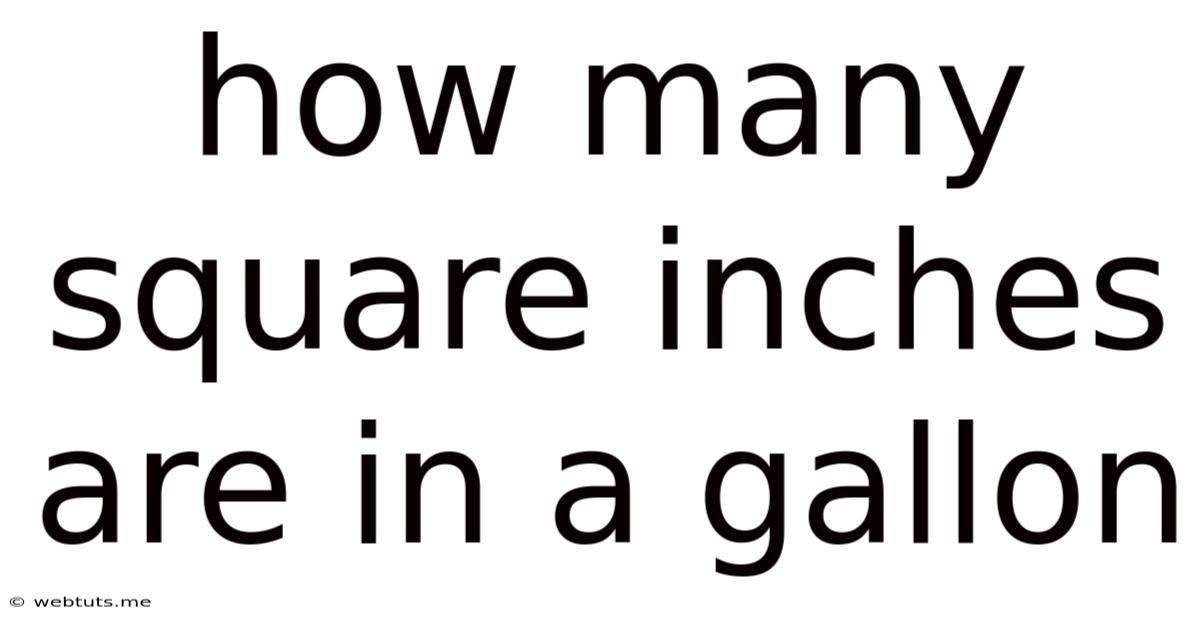How Many Square Inches Are In A Gallon
Webtuts
May 10, 2025 · 4 min read

Table of Contents
How Many Square Inches Are in a Gallon? Understanding Units and Volume
The question "How many square inches are in a gallon?" reveals a fundamental misunderstanding of units of measurement. Square inches (in²) measure area, a two-dimensional space, while gallons (gal) measure volume, a three-dimensional space. You can't directly convert between them; it's like trying to compare apples and oranges. However, we can explore the relationship between volume and area in specific contexts and clarify the confusion. This article will delve into the intricacies of unit conversions, explore related concepts, and ultimately explain why a direct conversion isn't possible.
Understanding Units: Area vs. Volume
Before tackling the core question, let's solidify our understanding of the units involved.
Square Inches (in²)
A square inch represents the area of a square with sides measuring one inch each. It's a fundamental unit for measuring two-dimensional space, like the surface area of a table or a piece of paper. Think of it as measuring how much space something covers.
Gallons (gal)
A gallon is a unit of volume, measuring the amount of space a three-dimensional object occupies. Imagine filling a container with water; the gallon measures how much water the container holds. It's crucial to remember that volume considers length, width, and height, unlike area which only considers length and width.
The Flawed Question and its Implications
The question itself highlights a common misconception: confusing area and volume. To illustrate, consider a gallon of paint. The gallon describes the amount of paint you have, not the area it will cover. The area the paint covers will depend on how thickly you apply it. A thin coat will cover a much larger area than a thick coat, even though both use the same volume (gallon) of paint.
Trying to find a direct conversion between square inches and gallons is akin to asking how many miles are in a pound. They measure fundamentally different things – distance versus weight – making a direct conversion meaningless.
Exploring Related Concepts: Volume and Surface Area
While a direct conversion isn't possible, we can explore how volume and area relate in specific scenarios. Consider a container holding one gallon of liquid:
- The container's volume: This is directly measured in gallons.
- The container's surface area: This is measured in square inches and depends entirely on the container's shape and dimensions. A tall, slender container will have a different surface area than a short, wide container, even if both hold one gallon.
This highlights the crucial difference: volume is about content, while surface area is about external dimensions.
Calculating Surface Area of a Container (Example)
Let's consider a simple example: a cubic container holding one gallon. First, we need to know the equivalent cubic inches in a gallon:
- 1 US gallon ≈ 231 cubic inches (in³)
If our container is a cube, we can find the length of one side:
- Cube root of 231 in³ ≈ 6.13 in
Now we can calculate the surface area of this cube:
- 6 sides * (6.13 in)² per side ≈ 225 in²
Therefore, a cubic container holding one US gallon would have an approximate surface area of 225 square inches. However, this is specific to a cube. A different shaped container with the same volume will have a different surface area.
This calculation emphasizes that even with a specific shape, the relationship between volume (gallons) and surface area (square inches) remains dependent on the container's dimensions.
Practical Applications and Further Considerations
Understanding the difference between area and volume is vital in several practical situations:
- Painting: As mentioned earlier, knowing the gallonage of paint only tells you the amount; you still need to estimate the surface area to be painted to determine how many gallons you need.
- Packaging: Designers need to consider both the volume of the product (how much it holds) and the surface area of the packaging (for material costs and printing).
- Engineering: In various engineering applications, understanding volume and surface area is crucial for design, material selection, and cost optimization.
Conclusion: The Importance of Dimensional Analysis
The inability to directly convert gallons to square inches underscores the importance of dimensional analysis. It's a crucial skill in science and engineering, ensuring that units are correctly used and conversions are performed logically. Always ensure you're working with compatible units and understand the dimensions involved (length, area, volume, etc.) before attempting any conversion. The question itself highlights a common error – attempting to connect units measuring different dimensions. Instead of focusing on a direct conversion, focus on understanding the individual quantities and their relevance in specific contexts.
This detailed explanation should clear up the confusion surrounding the initial question and help readers better grasp the difference between area and volume, and the significance of dimensional analysis in various applications. The example calculations illustrate how volume and surface area are related, but only within the constraints of a specific shape and calculation method. Always approach unit conversions with care and a clear understanding of the quantities involved.
Latest Posts
Latest Posts
-
How Many More Days Until March 27
May 10, 2025
-
How Many Feet In 9 Miles
May 10, 2025
-
1 Kg Of Sugar To Cups
May 10, 2025
-
How Many Minutes Is 3 Days
May 10, 2025
-
What Was The Date 50 Years Ago
May 10, 2025
Related Post
Thank you for visiting our website which covers about How Many Square Inches Are In A Gallon . We hope the information provided has been useful to you. Feel free to contact us if you have any questions or need further assistance. See you next time and don't miss to bookmark.